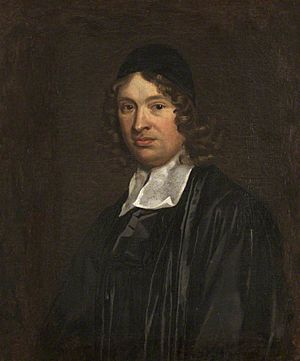Benjamin Woodroffe facts for kids
Benjamin Woodroffe (born 1638, died 1711) was an important English church leader and head of a college. He lived during a time of big changes in England, including the Glorious Revolution.
Contents
Early Life and Education
Benjamin Woodroffe was born in Oxford, England, in April 1638. His father was also a church leader. Benjamin went to Westminster School, a famous school, and then studied at Christ Church, Oxford, which is part of the University of Oxford. He earned his first degree in 1659 and a master's degree in 1662.
Around 1662, he became a well-known tutor at Christ Church. He was also interested in science! In 1663, he studied chemistry with other famous people like John Locke, who was a very important philosopher. Benjamin Woodroffe even became a member of the Royal Society in 1668. This was a group for top scientists and thinkers.
Career in the Church
Benjamin Woodroffe became a chaplain (a priest who serves a royal family or military) to James, Duke of York in 1669. He even served with the Duke during a naval battle called the battle of Sole Bay in 1672. This led to him becoming a chaplain to King Charles II in 1674.
He received many important positions in the church. He became a lecturer at the Temple Church in London and a canon (a type of priest) at Christ Church in Oxford. He also became a vicar (a local priest) in places like Piddlehinton and Shrivenham. Later, he was appointed to lead a church in London, St Bartholomew-by-the-Exchange, and became a canon at Lichfield Cathedral. He held these important jobs for the rest of his life.
Gloucester Hall and the Greek College
In 1692, Benjamin Woodroffe became the head of Gloucester Hall, one of the colleges at Oxford University. The college was not doing very well at the time. He worked hard to rebuild it and bring in new students.
He had a special dream: to create a place where young Greek students could come to England to study. He hoped this would help bring the Church of England and the Greek Orthodox Church closer together. Around 1697, he started building the Greek College, Oxford next to Gloucester Hall. However, the building was not very strong, and people sometimes called it "Woodroffe's folly."
Even so, some young Greek students came from Smyrna to study there. But there were some problems, and the church leaders in Constantinople eventually told students not to study at Oxford.
Benjamin Woodroffe also tried to get a large amount of money from a wealthy man named Sir Thomas Cookes, 2nd Baronet to help Gloucester Hall. However, there were disagreements, and the money did not come to the college until after Woodroffe had passed away.
Later Life and Death
In his later years, Benjamin Woodroffe faced some financial difficulties. He had bought a large estate in Marbury, Cheshire, but he ran into trouble completing the purchase.
Benjamin Woodroffe died in London on August 14, 1711. He was buried in his church, St Bartholomew-by-the-Exchange.
Writings
Benjamin Woodroffe wrote several books and poems during his life. Here are some of them:
- Somnium Navale (1673): A Latin poem about the battle of Sole Bay.
- The Great Question how far Religion is concerned in Policy and Civil Government (1679): A book about how religion and government are connected.
- The Fall of Babylon: Reflections on the Novelties of Rome by B. W., D.D. (1690): A book discussing different religious ideas.
- O Livro da Oração Commun (1695): He helped translate the English prayer book into Portuguese.
- Daniel's Seventy Weeks explained (1702): A book explaining a part of the Bible.
He also published other sermons and poems.
Family
Benjamin Woodroffe was married twice. In 1676, he married Dorothy Stonehouse. Later, he married Mary Marbury.


